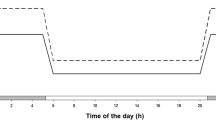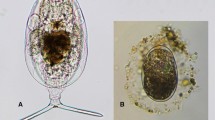Abstract
The primary and secondary productivity of the pelagic zone of Lake Constance has been investigated since 1980. During the growing seasons (May to autumn) two Daphnia species were the dominant herbivores. The productivity of the two Daphnia populations was estimated from the dynamics of their population densities, their individual body weights, and their development times. The seasonal course of the population densities can be generalized as a logistic growth with a log-phase in spring and a subsequent food-limited equilibrium density throughout the summer. Body weights varied according to nutritional state (as measured by the average clutch size) /1/. Development times were estimated as function of body size and environmental temperature /2/, the latter of which was monitored in a detailed investigation of the specific vertical migration of the Zooplankton populations and simultaneous recording of the lake temperatures in 10-min-intervals within the upper 40 meters of the water column /3/. Daphnia galeata showed no migratory behaviour and, living in the warm epilimnic layers, had short development times. D. hyalina began to migrate in June when the population density reached equilibrium. Its development was prolonged, therefore, by the low hypolimnetic temperatures as experienced during the days.
Access this chapter
Tax calculation will be finalised at checkout
Purchases are for personal use only
Similar content being viewed by others
Abbreviations
- DW:
-
dry weight
- B:
-
standing crop biomass (g DW/m2)
- P:
-
cumulative annual production (g DW/m2.year)
- P/B:
-
turnover rate
- B/P:
-
turnover time (days), both refer to the growing season of 200 days
- B/R:
-
energy residence time = relation between pool size (B) and flow of energy through the pool (R: cumulative annual respiration)
References
Geller, W. and Müller, H.: Seasonal variability in the relationship between body length and individual dry weight as related to food abundance and clutch size in two coexisting Daphnia species, J. Plankt. Res. 7 (1985) 1–18.
Geller, W.: On estimating the age and the development time of Daphnia as function of body size and temperature, J. Plankt. Res. 9 (1987) 1225–1230.
Geller, W.: Diurnal vertical migration of Zooplankton in a temperate great lake (L. Constance): A starvation avoidance mechanism?, Arch. Hydrobiol. Suppl. 74 (1986) 1–60.
Morowitz, H.J.: Energy flow in biology: Biological organization as a problem in thermal physics. Acad. Press, New York 1968.
Cheslak, E.F. and Lamarra, V.A.: The residence time of energy as a measure of ecological organization. In: Energy and ecological modelling. Mitsch, W.J. and Bossermann, R.W. (Eds.). Elsevier, Amsterdam 1981.
Tilzer, M.M.: The importance of fractional light absorption by photosynthetic pigments for phytoplankton productivity in Lake Constance, Limnol. Oceanogr. 28 (1983) 833–846.
McNeill, S. and Lawton, J.H.: Annual production and respiration in animal populations, Nature 225 (1970) 472–474.
Author information
Authors and Affiliations
Editor information
Editors and Affiliations
Rights and permissions
Copyright information
© 1988 Springer-Verlag Berlin Heidelberg
About this paper
Cite this paper
Geller, W. (1988). Trophy-Balanced Turnover Velocities in a Two-Species System of Competing Daphnids: A Test of the “Energy Residence Time” Concept. In: Wolff, W., Soeder, CJ., Drepper, F.R. (eds) Ecodynamics. Research Reports in Physics. Springer, Berlin, Heidelberg. https://doi.org/10.1007/978-3-642-73953-8_12
Download citation
DOI: https://doi.org/10.1007/978-3-642-73953-8_12
Publisher Name: Springer, Berlin, Heidelberg
Print ISBN: 978-3-642-73955-2
Online ISBN: 978-3-642-73953-8
eBook Packages: Springer Book Archive




